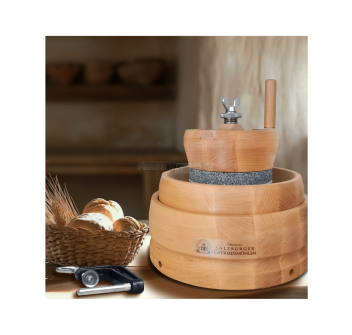How many types of grain mills are there?
If you are a grain enthusiast and are thinking of purchasing a grain grinder for grains, then you are in the right place! In this article, we will walk you through the different types of mills available on the market.

When it comes to grain mills, there are several types to choose from, each with their own features and benefits. Let's see together what they are:
1. Stone Mill : This is the most traditional type of grain mill. The stones grind the grains slowly but effectively, keeping the flavor and texture of the grains intact. This type of mill is perfect if you love the authentic taste of home-ground grains.
2. Impact Mill : This type of mill uses a series of rotating blades to grind grains. It's very fast and efficient, but it may slightly alter the taste of your cereal. If you're looking for fast, precise grinding, this might be the type of mill for you.
3. Roller Mill : This is a type of mill that uses two rotating cylinders to crush grains. It is known for producing a very fine and uniform flour, ideal for cakes and leavened breads. If you need an extremely precise and fine grind, then this is the type of mill you should consider.
4. Hammer Mill : This type of mill uses rotating hammers to break grains into small pieces. It is perfect for grinding harder grains such as barley or buckwheat. If you need to grind sturdier grains, then a hammer mill may be the right choice for you.
5. Manual mill : If you are a lover of manual work and want to conserve electricity, then a manual mill could be the ideal choice for you. This type of mill requires a certain amount of physical effort, but allows you to enjoy the process of grinding grains by hand.
We hope this guide has helped you better understand the different types of grain mills available on the market. Always remember to take your personal needs and preferences into consideration when choosing the grain mill that is best for you. Each type of mill has its advantages and disadvantages, so it is important to carefully evaluate the features of each model before making a decision.
Before purchasing a grain mill, be sure to also consider other factors such as grinding capacity, ease of use and cleaning, and the durability of the mill itself. Additionally, also check out user reviews online to get an idea of other people's experiences with the mill you are considering.
Once you've chosen your ideal grain mill, you'll be ready to start grinding your favorite grains at home. You will be able to enjoy fresh homemade bread, flour for delicious desserts and much more. There's nothing better than being able to completely control the grain milling process and enjoy the results in your kitchen.
Don't miss the opportunity to change your diet and live a unique experience with a cereal mill. Choose the one that best suits your needs and start enjoying all the taste and freshness of home-ground cereals.
Purchasing a cereal mill is an investment that will allow you to always have fresh and nutritious flours at hand for your culinary preparations. Don't put off this choice any longer: start exploring the world of grain mills and discover everything you can achieve with a quality product.
Why use a hand-cranked grain mill?
Using a hand crank mill instead of an electric mill has several advantages that may be attractive to some people:
-
Total Control: With a hand mill, you have complete control over the speed and pressure when grinding. This allows you to achieve the desired consistency for your ingredients, which may be more difficult to achieve with an electric mill.
-
Quiet: Hand mills are generally much quieter than their electric counterparts. This can be beneficial, especially if you're grinding grains or other ingredients in an environment where the noise might be bothersome.
-
No energy consumption: Hand mills require no electricity, making them ideal for situations where you don't have access to an electrical outlet or want to save energy.
-
Portability: Hand mills are often more compact and lightweight than electric mills, making them easy to transport and use when traveling or camping.
-
Durability: Because they have no complex electrical parts, hand mills tend to be more durable and less prone to failure than electric mills.
-
Energy saving: The use of a hand mill can be considered an ecological gesture, since it does not contribute to the consumption of electricity.
However, it is important to note that there are also some limitations in using a hand mill. Manual grinding can require more time and physical effort than an electric mill, so it may not be the best choice for those who need to grind large quantities of ingredients quickly and efficiently.
Choosing between a hand crank mill and an electric mill depends on your personal needs, the amount of grinding you plan to do, and your individual preferences for control and grinding experience.
How is the stone mill made?
Do you want to find out how a stone grain mill works? You are in the right place! In this article I will reveal all the secrets of this fascinating machine with an ancient tradition.
The stone mill is an essential tool for the production of cereal flour. Its history dates back thousands of years, when man learned to grind cereals to obtain flour. Today, despite technological advances, the stone mill continues to be used to produce high quality flour.
But how is a stone mill made? First of all, it is made up of two large stone wheels which are called grindstones. These grinding wheels are usually made of granite or other hard, wear-resistant rocks. Their surface is rough and grooved to facilitate the grinding of cereals.
The two grinding wheels are arranged one above the other, with a small space between them called the "barrel". The cereals to be ground are poured into the barrel and, thanks to the rotation of the grinding wheels, they are crushed and reduced to powder.
The force needed to rotate the grinding wheels can be generated in various ways. In traditional mills, the rotation of the grinding wheels occurs thanks to water or animal energy. Today there are also modern mills that use electricity to operate the grinding wheels.
Once the cereals have been ground, the flour is collected in a special tank. From here it can be transferred into containers or bags for transport and sale.
The stone mill is appreciated for several reasons. First of all, it guarantees slow and delicate grinding of the cereals, thus preserving all the nutritional and organoleptic properties of the flour. Furthermore, thanks to its solid and robust structure, it is a mill that lasts over time and requires little maintenance.
If you are a lover of high quality flours, you can't do without a stone grain mill in your kitchen. Thanks to its ability to grind cereals on the spot, you will be able to enjoy bread, pasta and desserts with fresh and genuine flours.
Not only will you get tastier flours, but you will also be able to experiment with different varieties of cereals and create customized blends. The stone mill will allow you to give free rein to your culinary creativity and enjoy the pleasure of preparing homemade food with quality ingredients.
In conclusion, the stone grain mill is an important machine that has ancient roots but continues to be used today. Its simple but effective structure guarantees slow and delicate grinding, preserving all the nutritional properties of the cereals. If you are passionate about cooking and want to obtain fresh and genuine flours, you cannot do without a stone mill in your kitchen. Whether you are a professional or a simple enthusiast, this tool will offer you endless creative possibilities and the pleasure of enjoying homemade food. Don't hesitate, find out now how a stone grain mill works!
What stone is used to grind grain?
If you are a cooking enthusiast and want to make your own wheat flour to make delicious bread, pasta or desserts, then you need a grain mill. But which stone is best to use for grinding grain?
Choosing the right stone for your grain mill is crucial to obtaining high-quality flour. The stones used in traditional mills are usually made of granite or quartz. Both stones are durable and wear-resistant, ensuring effective and uniform grinding of grain.
Granite is a popular choice due to its hardness and heat resistance. This stone is able to grind the grain evenly, keeping all its nutritional properties intact. Furthermore, granite does not absorb the oils or flavors of ground grains, thus ensuring pure, contamination-free flour.
Quartz is another excellent option for grinding grain. This stone has similar properties to granite, but can also be more resistant to wear and scratches. Quartz is also known for its ability to generate less heat during grinding, thus preserving essential nutrients in the grain.
Some grain mills also offer the option of using composite stones that combine granite and quartz or other stone varieties. These composite stones offer even more effective grinding and can be adjusted to obtain different flour consistencies, from fine to coarse.
Regardless of the stone you choose for your grain mill, it is important to ensure that it is high quality and well constructed. Check product reviews and look for mills that have a good reputation for their efficiency and durability.
Now that you know the different grain grinding stone options, you are ready to choose your ideal grain mill. With a high-quality mill and the right stone, you can grind fresh wheat at home and enjoy superior quality flours for your favorite dishes.
Don't wait any longer, start your culinary adventure with a quality grain mill today!









